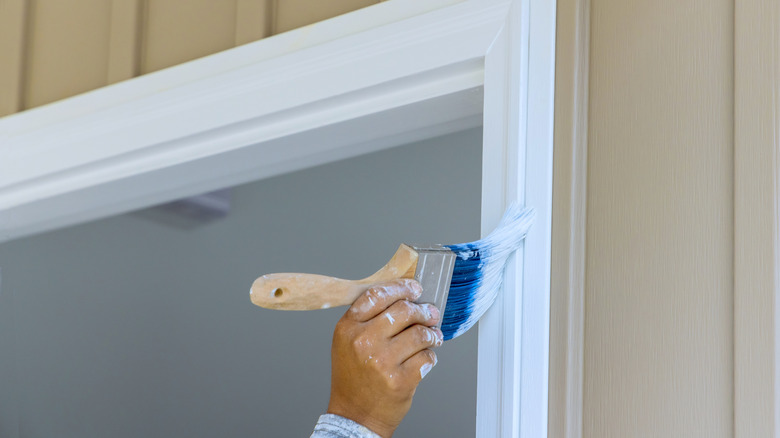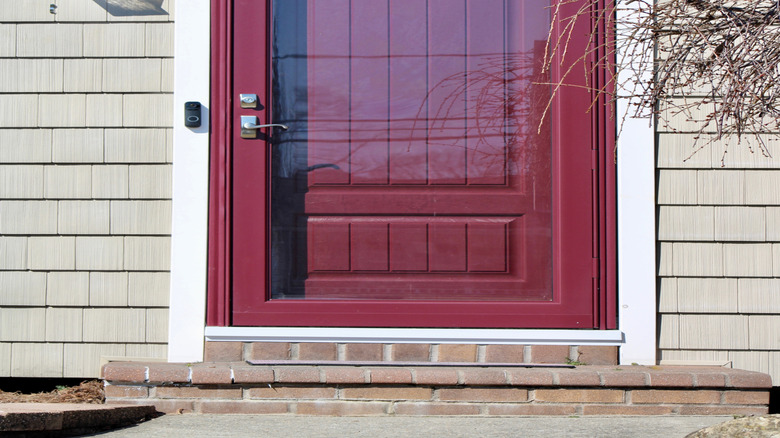How To Replace Brickmold On A Door
In an industry that sports butt splices, sprinklefitters, bunny guns, and knot wrenches, brickmold is special for being nothing special. Or at least seeming that way. "Brickmold" (sometimes spelled "brickmould") might be a vaguely unpleasant term, but what it represents lives firmly on the pleasant side of mundane. "Brickmold is an external trim between the siding of a house and the frames of doors and windows," said Kevin Keen when House Digest spoke with him exclusively about the best way to replace brickmold on a door.
And Keen should know. He is a construction expert, contractor, and owner of Keen's Buildings, which specializes in buildings like custom metal garages, certified metal carports, metal barns, metal sheds, and other structures that are delivered pre-built. Keen says that the term has evolved a bit. Aside from merely filling the gap between door or window frames and exterior walls, it now has some other roles. "Brickmold can also be aesthetically pleasing," Keen said. "It also strengthens the installation's structural integrity, conceals the wall-frame joint, and adds an additional barrier to keep water out, protecting the house from potential moisture damage." In short, brickmold is an important part of extending the lives of your windows and doors.
How to replace brickmold on a door
When it's time to replace the brickmold on a door, you'll find that the process is straightforward, but there are absolutely ways to increase your chances of success. When House Digest spoke exclusively with Kevin Keen, a construction expert whose company, Keen's Buildings, has installed over 75,000 buildings, he said it all starts with the right tools: a pry bar, a utility knife, a hammer, finishing nails, caulk, clamps, and the replacement brickmold. The process starts, crucially, with cutting through the brickmold's caulk lines with a utility knife; failing to do this step can cause damage to the surrounding wood when the brickmold is removed. Then, use the pry bar to carefully remove the old trim without damaging the doorframe.
"Make sure that the top piece of the new brickmold slightly overlaps the jamb width when you measure and cut it to fit," Keen said. If you're using a replacement made of PVC, he added, be sure to angle its bottom edge to match the sill. Secure the new top piece first, clamping and then carefully nailing it into the correctly aligned position. Then attach the side pieces the same way. "Before painting with exterior-grade paint for durability, caulk all seams and nail holes to create a waterproof seal," Keen added. It is, after all, far simpler to replace brickmold than to go through the whole process of repairing water damage.
"You should always choose rot-resistant materials like composite or PVC," Keen summarized, "double-check measurements, caulk all seams and nail holes correctly, and always cut caulk lines with a utility knife."
Common mistakes and great tips for brickmold replacement
There are a few common mistakes — and best practices that help eliminate them — that anyone replacing a door's brickmold should know about. When House Digest spoke exclusively with 25-year construction veteran Kevin Keen, he said, "Over the years, I've seen a lot of common blunders when it comes to rebuilding brick molding. These include things like using non-durable materials, [such as] untreated wood, which can deteriorate prematurely." And it's not just the new brickmold itself that you should be concerned about. "Another mistake that people often make that causes headaches is insufficient sealing, which allows water intrusion and structural damage," Keen said.
Keen also gave us some great tips for successfully replacing a door's brickmold. Some, like drilling pilot holes in the molding to prevent splitting during hand-nailing, are great advice for any DIY home improvement project. Others are specific to brickmold, or at least to exterior trim. For example, PVC trim – an increasingly common type of wall molding — expands and contracts with temperature changes. "If you're working with materials like PVC," he said, "leave small gaps at joints and use flexible caulk to seal them to allow for expansion and contraction."
And don't forget maintenance. "To make sure that you're ensuring long-term durability and to maintain the brickmold's integrity and appearance," Keen said, "check and recaulk it on a regular basis."


